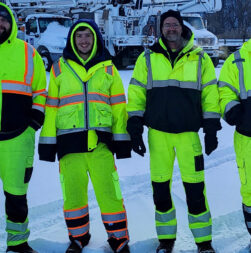Driving through work zones is just part of being on the road. As inconvenient as they can be, they’re a necessary part of keeping transportation infrastructure in good repair. However, navigating work zones presents unique challenges and hazards that demand special attention from drivers. So, let’s look at work zone safety, including hazards and best practices for keeping drivers and workers safe and secure.
Common Driving Hazards in a Work Zone
Work zones aren’t just a section of the road with orange cones and signs; they are active construction areas with potential dangers. Here are some common hazards drivers may encounter:
- Low-Hanging Wires: Work zones often involve overhead work, like repairing power lines or streetlights. Drivers should be vigilant about low-hanging wires and keep a safe distance to prevent accidents.
- Open Excavations or Trenches: Construction work might require digging trenches or excavating road sections. These can be hard to see, so stay alert and follow posted detours if necessary.
- Equipment and People Entering and Exiting: Construction vehicles and workers constantly move in and out of the work zone. Watch for them and be prepared to yield the right of way.
How Can Drivers Help Protect Work Zone Safety?
The responsibility for safety doesn’t solely rest on construction workers but also includes drivers passing through these zones. Here are some crucial tips for drivers:
- Slow Down: As you enter a work zone, reduce your speed. Many states have specific speed limits for work zones, often lower than regular road speed limits. Always obey these limits.
- Pay Attention: Keep your focus on the road and your surroundings. While it’s essential to acknowledge the work being done, your primary responsibility is safe driving. Avoid distractions like cell phones or eating, which can lead to accidents.
- Start Slowing Down Early: Work zones can extend for miles, and hazards may be present throughout. Begin to slow down when you see the first work zone sign, and be prepared for what lies ahead.
The Role of Flagger Force in Work Zone Safety
Flagger Force is committed to ensuring the safety of both drivers and workers in work zones. This starts with diligently following federal, state, and local laws regarding setting up and maintaining safe work zones. These regulations provide a framework for mitigating hazards and ensuring safety for all.
Next, effective communication is critical because proper communication reduces confusion in work zones. Flagger Force teams emphasize clear and efficient communication among workers and drivers to prevent accidents and streamline traffic. This communication includes the use of work zone signs. Here’s what each type of sign means:
- Awareness Sign: The first sign you encounter alerts you that road work is ahead. This is a warning to get ready for potential changes in traffic flow.
- Activity Sign: The second sign specifies what work is being conducted. It may indicate lane closures or detours.
- Preparation Sign: The last sign instructs you on what to expect next. For example, it might indicate the presence of a flagger or a lane merge.
Ultimately, safe driving in work zones is a shared responsibility. While construction workers do their part in maintaining and improving our infrastructure, drivers must do their part by adhering to speed limits, staying alert, and following the guidance of work zone signs. Together, we can ensure the safety of workers and drivers alike.
Flagger Force plays a crucial role in this effort by ensuring compliance with safety regulations and effective communication within work zones. By following these guidelines and working together, we can make our roads safer for everyone. Remember, safety should always be the top priority in work zones, so slow down and pay attention. That way, you’ll get home safely, as will those workers.


